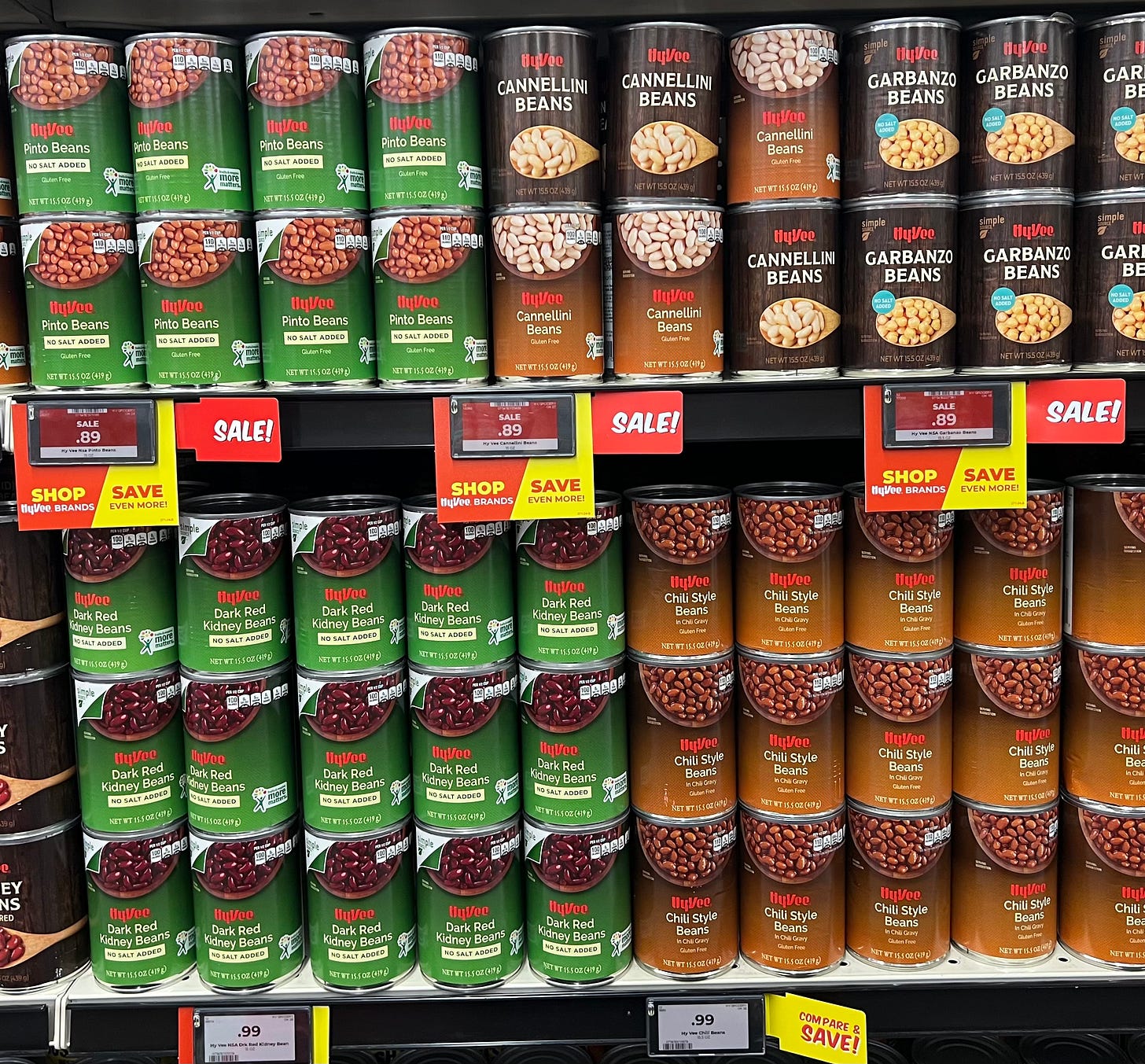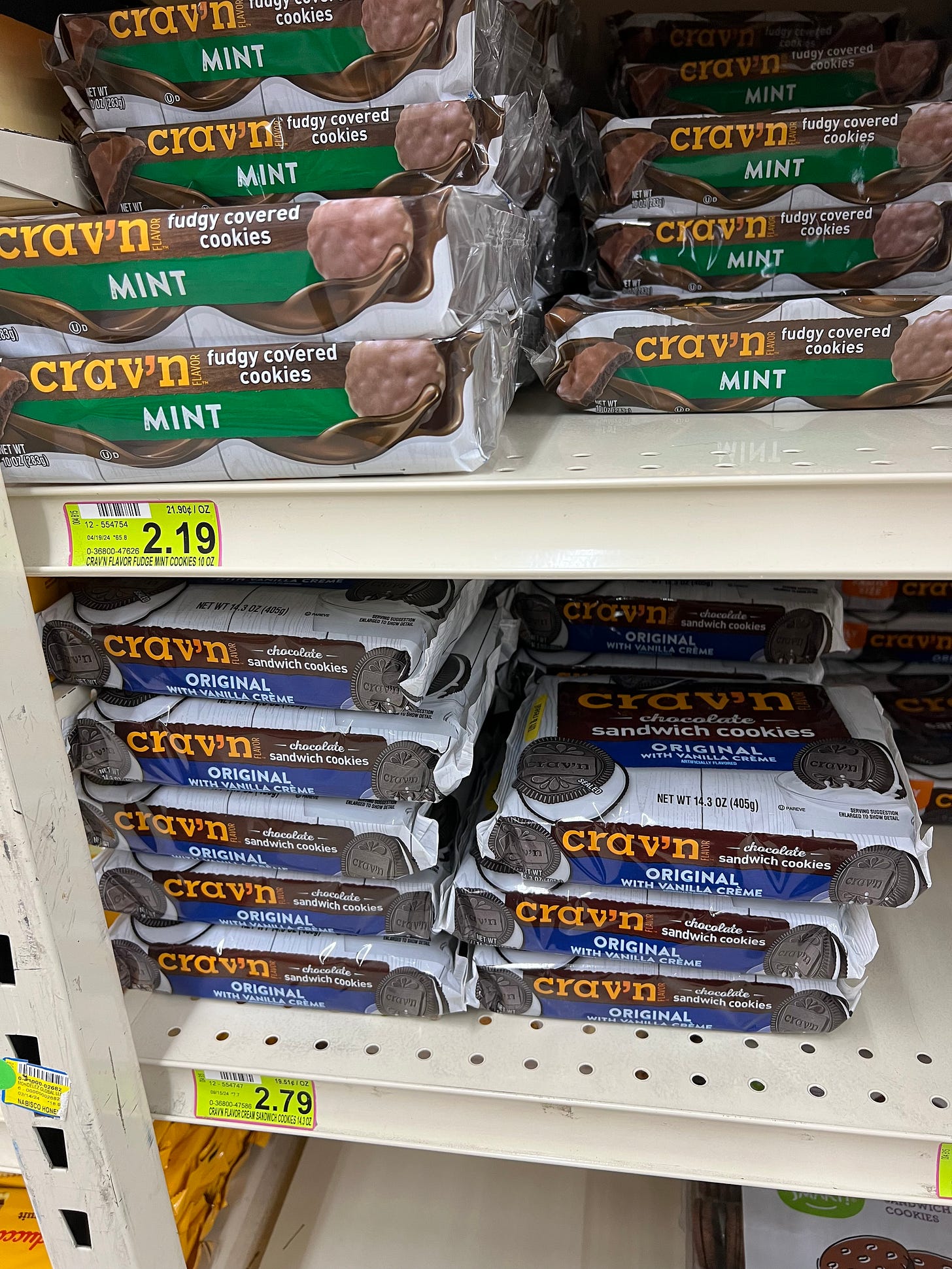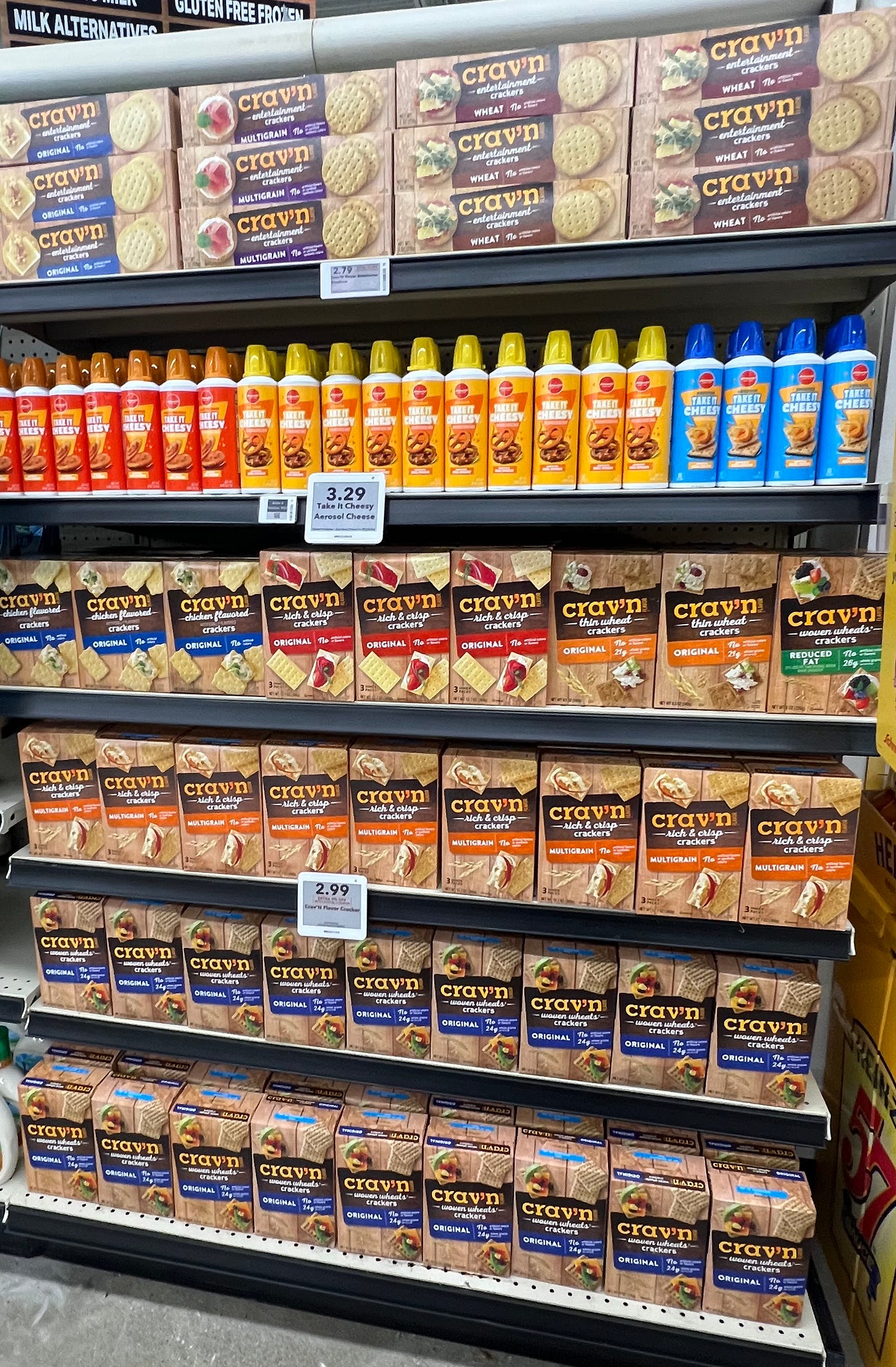Grocery Update #65: How Store Brands Conquered Grocery.
Surfing The Private Label Tsunami? Paddle Harder.
How Store Brands Conquered Grocery.
By Errol Schweizer, with data provided by NIQ.
Sometime during the 2024 Holiday Season, that heady time before tariffs and trade wars dominated food industry discourse and well before #MAHA meant gutting the food safety staff at the FDA, I checked in with a longtime friend and colleague, an executive at a natural products brokerage. I asked him how things were going… and he just unloaded on me. Store brands, across all retail segments, grocery categories and metro markets, were kicking his ass, hogging display space, and siphoning customer dollars and crucial holiday market share away from the innovative emerging brands that his group represented, tanking their revenue and his commissions, making the holiday season more of a Grinch-fest than a season of cheer. The store brands tsunami was consuming everything in its wake, and still isn’t slowing down.
Store brands, or private labels, continue to gain market share and consumer trust, new research from NIQ shows.
The year over year growth of store brands far exceeds that of national brands and it is accelerating. Over 59% of US consumers would buy more private label products if a larger variety were available. The success of store brands not only puts national brand names on notice as they see slower sales after years of price over volume strategies that increased profits at the expense of growth, but store brands momentum also creates huge hurdles for emerging and startup brands to get on shelf and succeed at retailers.
U.S. store brand sales were over $236 billion in 2023 and grew another 4.1% in 2024. This is an increase of over $62 billion since Covid-19 began. Over 22% of groceries sold in the U.S. were private label and over 98% of U.S. households bought them.
What are store brands, also known as private labels? They are product lines wholly owned by the retailers, their service partners or their distributors. These are brands such as Great Value, Good & Gather, Food Club, Crav’n, Field Day, 365, Simple Truth, Lucerne, Full Circle, Simple Nature, Hill Country’s Best, or Cadia. There is a whole industry of private label manufacturers with vast infrastructure, capabilities and expertise that makes these products for grocery chains, with much of the manufacturing done domestically, or Trump tariff-free.
The packaging, the ingredients, the supply chain, the nutritional information, everything that makes up the product itself, is proprietary for the retailer or wholesaler who formulated it, developed it, and distributed it, making store brands a compelling growth strategy for retailers facing increased competition, economic headwinds, and declining consumer confidence and spending power.
The quality and packaging of store brands has increased enormously in the last few decades, with many products comparable to the national brands that they imitate and compete with. These are not your grandpa’s generic white labels.
But the growth of store brands also tracks closely with household economic strains that have grown rapidly in the past few years, particularly in the early stages of the Covid-19 pandemic, again after 2022, when pandemic-era benefits were eliminated with the support of both U.S. political parties and in in the present moment, with a federal government that is gung-ho on scaling back social safety net programs such as SNAP and WIC that redistribute close to one hundred billion in public funds that cash-strapped consumers spend in grocery stores every year.
Declining real wages and the increased cost of living from years of food price inflation have put enormous pressures on working households.
All in all, grocery prices have climbed over 31% in the past five years, and over 50% in many key categories, correlating with a significant decrease in unit volumes across most product categories in the grocery sector since 2019. The average cost of a loaf of white bread has increased from $1.38 to $1.94 since 2020, a change of over 40%, while many processed consumer goods have gone up even more.
Egg prices have skyrocketed in the wake of Avian Flu culls, due to price gouging and extreme profiteering by egg marketing monopolies, while the four processors that control 90% of frozen potato manufacturing raised prices nearly 70% in three years and reaped enormous profits. For over three years, publicly traded food manufacturers raised prices above the rate of inflation, bragged about this on earnings calls, harvested billions in profits that they distributed back to shareholders, who in turn rewarded these companies with higher stock prices, causing unit volumes to decline precipitously as consumers scaled back purchases and started buying more store brands.
Food now costs a lot more, so people are buying less food, using food banks or trading down to lower priced products.
Over 90% of consumers are concerned with high food costs. In 2023, over 70% were financially stressed, 58% living paycheck to paycheck. The share of income spent on food increased 13% to the highest rate in 30 years. Food insecurity rates rose 18% in the last 2 years. Over one in three Black adults and nearly two in five Hispanic adults were food insecure in 2023, and over 47 million people lived in households experiencing food insecurity, an increase of 13.5 million compared to 2021 when pandemic-era benefits were in place. Nearly one in four households are now using “buy now, pay later” installment programs to afford groceries.
Food apartheid, therefore, is no longer a fringe concept.
About one in three Americans say they’re struggling to afford their usual expenses and more Americans are having difficulty paying bills. Poverty is up 65% since 2021, child poverty has tripled and 67% of Americans are living paycheck to paycheck. If wages had kept pace with productivity since 1975, Americans would have a $24 an hour minimum wage, and the bottom 90% of wage earners would have earned nearly $79 trillion in additional income, or over $3.9 trillion more annually. While some states have increased their minimum wages through ballot measures, the federal minimum wage sits at $7.25, hasn’t increased since 2009 when food was a lot cheaper, and likely won’t increase under the working-class pandering Trump Administration.
Trade wars, tariffs, deportations of undocumented immigrants, climate change and global conflicts will undoubtedly make these economic indicators worse, and neither a Trump Administration high on its own fumes nor the hapless Democrats will mitigate this pain in the short term. Consumers will continue to look for ways to save money and get better value from the products they can still afford. Store brands have now become more of a “need to have” than a “nice to have” for consumers.
Store Brands: Right Time, Right Place.
Store brands offer a seeming respite from these bearish economics. While these private labels have also increased in price substantially since 2019, they are built to remain significantly cheaper than national brands, and they have stayed that way. Retailers and their store brand suppliers do this intentionally. The products are formulated as close as possible to the national brand equivalents that dominate grocery shelves. Think Kraft Mac & Cheese, Oreo Cookies, Triscuit Crackers, Ragu Marinara, Bush’ Baked Beans, Coca-Cola, etc. The store brands suppliers try to match ingredients and nutritional content, flavor profiles, texture and mouth feel, all the organoleptic qualities that make the national brands so popular and craveable, while cutting as few corners as possible, at least none that customers will notice or will create an embarrassing food safety fiasco.
Store brand suppliers negotiate everyday low costs with manufacturers, pulling out all monies for promotions, advertising, retail media, or couponing that national brands typically budget for in their cost structures. This process gets store brands to a “dead net” cost, or everyday low price, a retail price based on efficiencies of volume and velocity, the products intended to sell faster and more frequently than competitors in their categories. And the store brands tend to be more profitable than many national brands, with higher gross margins that are very popular with store and department managers whose jobs depend on achieving sales and margin targets regularly. This plus the lower prices in an ongoing inflationary environment make store brands a winner, a good offense and defense for acquiring and retaining customers while fending off competitors. It is no wonder that retailers that are everyday low price and store brand-heavy, like Lidl, Aldi and Trader Joe’s, are growing rapidly, or that specialty formats like Sprouts and Natural Grocers are expanding store brands’ presence to grow their sales and customer traffic.
Shifting to more store brands can be a risk for retailers. National brands use a range of strategies to stay dominant on shelf, including tens of billions of dollars for retailers in the form of trade promotions, couponing, advertising and slotting fees to purchase space on shelf or for displays, as well as category captain arrangements with key retail partners where they provide data and insights in exchange for a “most favored nation” status in their product categories. Giving up some of these monies to make room for store brands is a big deal. But putting competitive pressure on the big, incumbent national brands to work harder and spend more to stay on shelf and in the good graces of their retail partners makes the risks seem worth it.
Some of the most popular brand names in the U.S, with the highest sales, household penetration and customer favorability are mass merchant store brands such as Walmart’s Great Value and Costco’s Kirkland. Kroger and Albertsons have dozens of store brands across their various retail banners that dominate center store categories, including favorites such as their eponymous labels and Simple Truth, Safeway O, Lucern and Signature Select. Regional independents such as HEB, HyVee, Wegman’s and ShopRite not only make their own store brands across hundreds of products, but also work closely with Topco, a private label cooperative services provider that supplies thousands of products to independent grocers across the U.S., with brands such as Food Club, Full Circle and Crav’n, and enables such indies to compete on price, assortment and retail experience with much larger mass merchants. Even natural/specialty grocers work with wholesalers such as UNFI, KeHe and Chex to expand private label penetration in stores, with brands such as Cadia, Field Day, Woodstock Farms, Daily Pantry and Laurel Hill taking up more space and customer wallet share every year in a sector more known for higher prices and championing new food trends and innovative emerging brands.
The new research from NIQ validates much of the buzz behind store brands.
Shoppers select retailers based on their store brand offerings, with 72% of US consumers saying private labels are good alternatives to name brands. For 54% of U.S. consumers, whether their favorite product is a national brand or store brand is irrelevant; they just buy what they need and can afford.
Over 75% of US consumers say private labels are good values for the money and have fewer perceived quality differences. And 49% of US consumers say they’re buying more private label. The 4.1% YOY growth of store brands is much higher than the 1.7% growth for national brands.
NIQ predicts that store brands will continue to gain share, as quality continues to improve, value strengthens, and shoppers become more accepting. Consumers still select national brands over private label in most cases, but their value propositions will be relentlessly challenged by store brands, especially since store brands have direct path to distribution at retailers, with most chains requiring all stores to stock their own brand labels. Store brands are also rapidly innovating and evolving to meet new consumer expectations, and are taking chances on uniqueness. These strategies are putting national brands on the defensive, but also making the hurdles for acceptance and success of emerging brands that much more challenging.
Retailers will continue to innovate and evolve private label offerings to maintain momentum, especially as these financial trends stay positive and the household economic indicators continue to show strains. This means the future for store brands looks very bright and they will be a growth segment for retailers investing in them aggressively.
Store brands’ values, quality and innovation will be a minor bright spot for consumers whose economic prospects continue to look bleak. Improving the present state of consumer and household macroeconomics, such as through public spending measures and an expanded social safety net, better labor protections and higher wages, easing of trade war tensions and investments in public infrastructure, would all need a significant reversal in the current Trump Regime policy and regulatory direction, and this in turn would require huge public pressures to achieve. Store brand growth in this context may be a pressure release valve for the ongoing socioeconomic unrest, i.e., “let them eat private label” as a cheaper, more accessible alternative to the inflation-profiteering national brands that are pricing themselves out of reach and making food apartheid the de facto status of the American consumer.
But in the meantime, for the sales brokers and troves of innovative emerging brands whose business models, payrolls and livelihoods depend on strong consumer confidence and spending habits, they will just keep paddling harder in the midst of the store brands tsunami.
peace.







